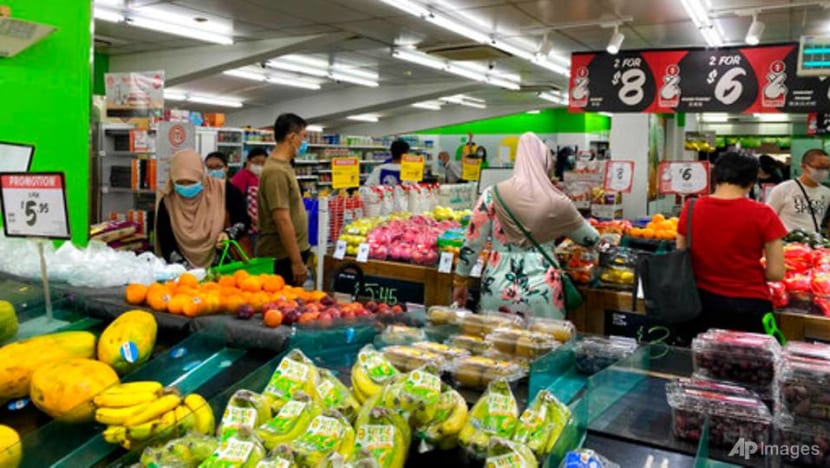Commentary: Inflation and Ukraine war make it challenging for our beloved value stores to survive
After the pandemic, businesses face global inflationary pressures and rising commodity prices due to war in Ukraine and sanctions against Russia. It’s a perfect storm for value stores serving budget-conscious consumers, say SMU’s Aurobindo Ghosh and DBS’ Taimur Baig.

A sign showing the change in prices at the Daiso outlet at City Square Mall. (Photo: CNA/Jalelah Abu Baker)
SINGAPORE: Japanese retail chain, Daiso, is known for its S$2 prices. News that it will move to a 15-tier pricing system from S$2.14 to S$25.47 from Sunday (May 1) was met with protests and promises by netizens that they would stop patronising the chain.
Daiso attributed this move to a "steady rise in raw material costs and logistics". It’s reasonable to see this as a sign that global inflationary pressures have hit our beloved value stores.
Both actual and expected inflation have picked up in Singapore. Inflation rose to a 10-year high of 5.4 per cent in March, according to the authorities. A survey run by DBS-SKBI to gauge inflation expectations finds that a cross section of Singaporean households expect inflation to remain elevated.
Consumers will be more conscious of how inflation shrinks their dollar. To the particularly value conscious, as long as popular discount stores such as Daiso and Valu$ are available for everyday items, including food and household necessities, life may be just fine.
The COVID-19 pandemic has already brought about massive changes: The global supply chain was disrupted with widespread movement restrictions and border closures. At the same time, governments instituted levels of monetary policy easing comparable only to the aftermath of the 2008 Global Financial Crisis, as well as job support schemes, flexible schedule of loan repayment, and direct cash transfers.
But the stimulus-fuelled demand and a still disrupted supply chain manifested in an outburst of inflation not seen in many decades, since the early 1980s.
War in Ukraine since February and the consequent economic sanctions against Russia only made things worse, driving up prices of oil, food and other commodities.

BUDGET-CONSCIOUS CONSUMERS AT THE HEART OF VALUE STORES
Businesses everywhere are feeling the pinch. Value stores have not been spared - they have been hit by price spikes in palm oil, processed sugar, aluminium and plastics, among other key materials.
They tend to have varied business models but largely centre around inexpensive cost of operations, from outsourced manufacturing and parallel imports to buying in bulk in quantities far greater than other retailers. Price rise of the products sold, pressure on higher wage rates, and pass-through rental and distribution costs, are bound to hurt their profit margins.
Value stores face pressures to increase retail price to offset rising input costs. But even S$0.50 more can look disproportionately large against low retail prices – the main value proposition.
Product choice for value stores is typically made up of many wants (such as snacks, toys, trinkets, household items) rather than just needs. Wants are often highly elastic or price sensitive. Demand goes down when prices go up.
But since value store products are mostly imported, the Monetary Authority of Singapore’s recent monetary policy tightening can help manage such pressures. Allowing the Singapore dollar to appreciate means imports will be cheaper.
HARD TO ABSORB ADDITIONAL COSTS
Commercial rental costs, distribution costs and wages have gone up owing to supply factors and a tight labour market. Pandemic-related restrictions have made it difficult to hire workers and the retail sector has had to rely on part-time workers with irregular schedules.
Big supermarkets such as Walmart in the United States and NTUC FairPrice in Singapore can adjust to the uncertain labour market. but other businesses may find it harder to absorb such costs and may pass at least a part of the cost to consumers.
There is also fierce competition from online shopping platforms like Lazada and Shopee into the space where value stores thrive - shoppers buying discretionary products they initially did not intend to purchase. The cost of maintaining storefronts, warehouses and additional manpower for direct retail, makes it difficult for value stores to compete solely on price.
The dilemma now facing these discount stores is whether to price the same items higher or maintain prices for a lower quality item.
It is hardly surprising that in December 2021 after US chain Dollar Tree increased their prices from US$1 to US$1.25, there was a significant drop in customers satisfaction. Some retail analysts said it likely alienated loyal customers who were specifically keen on the dollar price tag.
Indeed, netizens reacting to Daiso’s pricing system changes suggest customers were particularly attracted by the S$2 prices that encouraged them to buy discretionary items “without thinking” and would prefer to seek better value in other chains or heartland shops.
DO VALUE STORES NEED TO RE-EVALUATE THEIR VALUE PROPOSITIONS?
So, what can value stores do to survive this perfect storm?
Today’s operating environment may prove an existential threat to value stores, forcing them to re-evaluate their reason for being, their purpose of existence. However, short of raising prices, the steps that businesses might take to stay competitive may mean major changes to value stores.
First, they can look at reducing costs of transportation, at a time when global shipping rates are expected to stay sky-high. This could be through sourcing more locally and regionally manufactured products, but this could drive input costs up compared to where manufacturing is done currently.
Second, reducing manpower costs is another way, such as through self-checkout kiosks or automation like vending machines. Singapore customers are no strangers to innovative solutions.

Third, businesses could focus on quality, as reputational damage arising out of lower quality products is costlier to fix than temporary drop in profit.
Finally, they could also appeal to the growing customer segment keen on environmental, social and governance (ESG). For example, they can carry products that are sustainably sourced or come from small artisans and family-run businesses in the community, or have shelf space dedicated to businesses run by or that employ the underprivileged.
HOW WILL CUSTOMERS RESPOND?
Could this fundamentally change the products and prices we associate with value stores? It might, but it doesn’t have to be drastic. Diversifying even part of their product offerings and manufacturing could already help to buffer some inflationary shocks.
International chains like Daiso seem to employ a global expansion strategy for the greater economies of scale and to absorb shocks across more markets. It has continued to open new stores in the US during the pandemic. But this might not be feasible for all value stores.
Working with the community to build trust, rather than having short-term profit motivation, might help value stores survive. Building trust would reduce customer acquisition cost (like advertising), create brand loyalty, reduce the impact of price sensitive consumers, and strategically focus on the stable economy in the long run to help build that bridge over troubled waters in the short run.
Will customers respond? It remains to be seen how Daiso customers will change their shopping habits. but other value stores may be watching to decide whether shifting gears or biting the bullet is the way to go.
Dr Aurobindo Ghosh is Assistant Professor of Finance Education and Principal Investigator DBS-SKBI Singapore Index of Inflation Expectations Project, Lee Kong Chian School of Business, Singapore Management University.
Dr Taimur Baig is Chief Economist and Managing Director at DBS Bank.






















